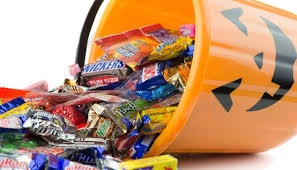04 Nov Halloween aftermath: 5 Tricks for Dealing With Halloween Treats
Children’s Halloween dream — to get lots of candy — can be their parents’ nightmare. But pediatric dental experts say Halloween can be a time to teach your children good oral health habits for life, without depriving them of Halloween treats (think moderation). Here are their five best tricks for healthy teeth.
Halloween Candy vs. Cavities: Don’t Make Kids Choose
Don’t deny your children the Halloween experience. That can send the entirely wrong message — deprivation — and make candy seem even more irresistible, leading to other problems. They may end up sneaking sweets or eating too much candy once they’re out on their own. Instead, let them have the joy of Halloween in all its sticky goodness and the experience of going to a party or trick-or-treating.
After your children get back from trick-or-treating or a party, go through their bags of Halloween candy together. Tell them to each pick the 10 or so (whatever number you decide, based on factors such as age) treats they want the most.
Get the unpicked treats out of sight. You can donate them to a food bank or freeze them if you can’t bear to throw them out. This can also be a good time to teach (or remind) children that it isn’t just excess sugar that can lead to cavities. Snacks such as pretzels, with starches that stay in the mouth longer, can also lead to cavities, as can fruit juices.
Letting children help decide what is a reasonable amount of candy to keep has benefits beyond good oral health. The message isn’t “candy is bad,” but that candy and other sweets, in excess, can lead to cavities. Children learn two important lessons:
- How to control their diets
- That what they eat relates to oral health, not just physical health
Preventing Cavities in Children: Set a Treat Time
With your child, set a time of day to eat Halloween candy. This ritual “treat time” may last long after Halloween and help promote healthy thinking about treats:
- Children learn that eating sweets shouldn’t be an all-day feast. Moderation is key.
- Knowing they have a specific sweet time can help make children less inclined to think about eating sweets at other times of the day.
Children’s Oral Health: Set Up a Teeth Brushing Schedule
No matter when treat time is, it’s crucial to brush soon after. If it is nighttime, for example, brushing and flossing teeth before bed will help sweep away the recent sweets. Fluoride mouth rinses for kids also help prevent tooth decay, according to the American Dental Association.
Until a child is 7 or 8 years old, a parent should help with teeth brushing, not simply supervise. Even after age 8, parents should supervise brushing. That includes friendly reminders to older children to brush and floss until they get to high school, when it should be a habit.
Use Disclosing Tablets, Swabs, or Solution
Some dentists use ”disclosing tablets” to spot bacterial plaque on teeth. These chewable tablets temporarily stain the plaque that builds up on teeth.
Parents can also use disclosing tablets, solution, or swabs to show children how well they are brushing or flossing their teeth — especially if they already have a cavity or two. A 12-pack of disclosing tablets is available over the counter and online for about $8.
You may want to schedule a disclosing session once a week or so, to keep your child on his toes.
Keep Teeth Brushing Fun
You should replace toothbrushes every three or four months anyway, so make Halloween an occasion for getting your child a new brush. Dentists say that when children like the toothbrushes, they are more apt to enjoy brushing. Children can choose from a variety of kid-sized brushes that feature cartoon characters and colorful designs. Young children typically can’t wait to use a new toothbrush.
Children also like to pick out their own toothpaste. Give your child the freedom to pick from gels or pastes, different colors, and different flavors. Just check the tube label to be sure it contains fluoride.
Check the condition of your child’s toothbrush from time to time. If it doesn’t look worn after weeks of use, he may not be brushing well. (recommended replacement is every 6 months)
By Kathleen Doheny
Source: WebMD Feature
Reviewed by Steve Drescher, DDS
View Article Sources
SOURCES:
Paul Reggiardo, DDS, past president, American Academy of Pediatric Dentistry; assistant clinical professor in pediatric dental residency training, University of Southern California School of Dentistry; pediatric dentist, Huntington Beach, Calif.
American Academy of Pediatric Dentistry Survey, 2008.
American Dental Association: ”From baby bottle to cup.”
WebMD: “Self-examination for dental plaque.”
Reviewed on June 20, 2012
© 2009 WebMD, LLC. All rights reserved.


